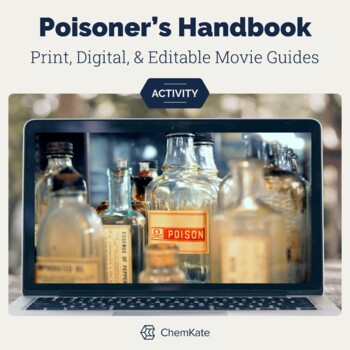Poisoner's Handbook Movie Guides Forensic Chemistry Print Self-grading Digital
- PDF
- Google Apps™

What educators are saying
Also included in
- Science movie guides for middle or high school science just became more amazing with these self-grading digital, editable, and printable question movie guides for you or subs. PBS science movies keep your students engaged, bring content to life, learn beyond the textbook, and provide teachable momenPrice $33.49Original Price $41.93Save $8.44
Description
Watching PBS’s Poisoner’s Handbook two-hour movie covering the beginning of forensic science and the chemistry behind it just became more amazing with these self-grading digital, editable, and printable 59-question movie guides! Keep your students engaged with a movie involving various poisons such as lead, radium, carbon monoxide, and denatured alcohol in the 1900s that can be broken into individual portions or shown as a whole. Even if a movie can't be shown in one class period, the Google form will keep students' answers for you! Great for regular or sub days. This movie can often be streamed for free from local libraries, such as through Hoopla, as well as commonly purchased on the PBS site.
✦ These time-savings and cost-savings guides are bundled with even more science movie guide(s) in the Science Movie Guides Bundle ✦
Includes:
- 59-question self-grading and editable Google form with times marked for each "chapter"/section
- PDF of movie worksheet and answer key
- Google slides of editable movie worksheet, which can be downloaded in various formats, such as Microsoft
Movie Synopsis:
In the early 1900s, poisons could easily be found in many over-the-counter products, and death by poisoning was a successful way to commit murder. In 1918, New York City hired Charles Norris as its first scientifically trained medical remainder. Norris and his chief toxicologist, Alexander Getter, went on to turn forensic chemistry into a formidable science. In two hours, students will be riveted by the interesting topic and great presentation, narrated in part by the author Deborah Blum.
Movie Chapter titles:
A Mysterious Death
Cyanide
Arsenic
Methanol
Lead
Carbon Monoxide
Denatured Alcohol
Radium
Durable Mike Malloy
Thallium
A Familiar Suspect
Public Health and the FDA
You may also like:
- Hunting the Elements Movie Guides - engaging video that explores basic chemistry, engineering, and silly humor. Editable and digital self-grading.
- Main Group Periodic Table Battleship - a fun game of main group element patterns
- Chemistry I Digital Task Cards - a wide variety of self-grading Boom cards and interactive Google slides
Interested in more?
Mole and Stoichiometry Resources
● Be sure to follow my store to be alerted of new products: CLICK HERE
● Did you know that you can receive credit towards future TpT purchases by reviewing this product? Please help my store grow by leaving a review at the product page or through "My Purchases" under "My Account" at TpT. I enjoy making products to help you be successful in the classroom, so if you have any other questions or suggestions, please contact me in the "Ask a Question" tab above.





